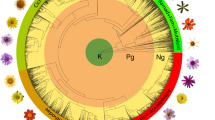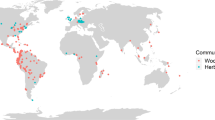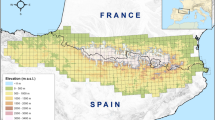Abstract
Explaining relationships between species richness and biogeographical patterns over a broad geographic scale is a central issue of biogeography and macroecology. We document the realized climate niches for grasses in China’s nature reserves and discuss its formation mechanism using grass richness data combined with climatic, physiological, and phylogenetic data. Our results suggest that climate niche structure of grasses is phylogenetically conservative for BEP (Bambusoideae, Ehrhartoideae, and Pooideae) and PACMAD (Panicoideae, Arundinoideae, Chloridoideae, Micrairoideae, Aristidoideae, and Danthonioideae) clades along temperature gradients and for Chloridoideae and Panicoideae along precipitation gradients. At the national scale, the divergence patterns of climate niches between two major clades are more distinguishable than between C3 and C4 grasses. High rates of climate niche evolution are found in C4 clades in the subtropical forest region. There appears to be a strong association between elevation gradients and grass diversity: the specific environmental conditions (e.g. energy) and the rapid shifts of climate conditions drive high grass diversification. Evolutionary conservatism of climate niches may be influenced by the specific adaptive ability to changing environmental conditions within NAD-ME/NADP-ME clades. Our results indicate that adaptations to major climate changes may be accomplished by C4 grass nodes of high climate niche evolutionary rates in China’s nature reserves.





Similar content being viewed by others
References
Archetti M (2009) Phylogenetic analysis reveals a scattered distribution of autumn colours. Ann Bot 103:703–713
Austin MP, Nicholls AO, Margules CR (1990) Measurement of the realized qualitative niche: environmental niches of five Eucalyptus species. Ecol Monogr 60:161–177
Belsky AJ, Mwonga SM, Amundson RG, Duxbury JM, Ali AR (1993) Comparative effects of isolated trees on their undercanopy environments in high- and low-rainfall savannas. J Appl Ecol 30:143–155
Bouchenak-Khelladi Y, Salamin N, Savolainen V, Forest F, van der Bank M, Chase MW, Hodkinson TR (2008) Large multi-gene phylogenetic trees of the grasses (Poaceae): progress towards complete tribal and generic level sampling. Mol Phylogenet Evol 47:488–505
Cabido M, Pons E, Cantero JJ, Lewis JP, Anton A (2008) Photosynthetic pathway variation among C4 grasses along a precipitation gradient in Argentina. J Biogeogr 35:131–140
Carmo-Silva AE, Francisco A, Powers SJ, Keys AJ, Ascensão L, Parry MAJ, Arrabaça MC (2009) Grasses of different C4 subtypes reveal leaf traits related to drought tolerance in their natural habitats: changes in structure, water potential, and amino acid content. Am J Bot 96:1222–1235
Chazdon RL (1978) Ecological aspects of the distribution of C4 grasses in selected habitats of Costa Rica. Biotropica 10:265–269
Chen SL, Li DZ, Zhu GH, Wu ZL, Lu SL, Wang ZP, Ammann KH et al (2006) Poaceae (Gramineae). In: Wu ZY, Raven PH, Hong DY (eds) Flora of China, vol 22. Science Press, Beijing and Missouri Botanical Garden Press, St Louis, pp 1–653
Collins RP, Jones MB (1985) The influence of climatic factors on the distribution of C4 species in Europe. Vegetatio 64:121–129
Crisp MD, Arroyo MTK, Cook LG, Gandolfo MA, Jordan GJ, McGlone MS, Weston PH et al (2009) Phylogenetic biome conservatism on a global scale. Nature 458:754–756
Donoghue MJ (2008) A phylogenetic perspective on the distribution of plant diversity. Proc Natl Acad Sci USA 105(Suppl. 1):11549–11555
Drummond AJ, Rambautx A (2007) BEAST: Bayesian evolutionary analysis by sampling trees. BMC Evol Biol 7:214
Drummond AJ, Ho SYW, Phillips MJ, Rambaut A (2006) Relaxed phylogenetics and dating with confidence. PLoS Biol 4:699–710
Edwards EJ, Smith SA (2010) Phylogenetic analyses reveal the shady history of C4 grasses. Proc Natl Acad Sci USA 107:2532–2537
Edwards EJ, Still CJ (2008) Climate, phylogeny and the ecological distribution of C4 grasses. Ecol Lett 11:266–276
Edwards EJ, Osborne CP, Strömberg CAE, Smith SA, C4 Grasses Consortium (2010) The origins of C4 grasslands: integrating evolutionary and ecosystem science. Science 328:587–591
Ehleringer JR, Cerling TE, Helliker BR (1997) C4 photosynthesis, atmospheric CO2 and climate. Oecologia 112:285–299
Epstein HE, Lauenroth WK, Burke IC, Coffin DP (1997) Productivity patterns of C3 and C4 functional types in the U.S. Great Plains. Ecology 78:722–731
Ghannoum O, von Caemmerer S, Conroy JP (2002) The effect of drought on plant water use efficiency of nine NAD-ME and nine NADP-ME Australian C4 grasses. Funct Plant Biol 29:1337–1348
Giambelluca TW, Schroeder TA (1998) Climate. In: Juvik SP, Juvik JO (eds) Atlas of Hawai’i, 3rd edn. University of Hawai’i Press, Honolulu, pp 49–59
Hattersley PW (1983) The distribution of C3 and C4 grasses in Australia in relation to climate. Oecologia 57:113–128
Hattersley PW (1986) Variations in photosynthetic pathways. In: Soderstrom RT, Hilu KW, Campbell CS, Barkworth ME (eds) Grass systematics and evolution. Smithsonian Institute Press, Washington, DC, pp 49–64
Hattersley PW (1992) C4 photosynthetic pathway variation in grasses (Poaceae): its significance for arid and semi-arid lands. In: Chapman GP (ed) Grass evolution and domestication. Cambridge University Press, New York, pp 181–212
Hattersley PW, Watson L (1992) Diversification of photosynthesis. In: Chapman GP (ed) Grass evolution and domestification. Cambridge University Press, New York, pp 38–116
Hof C, Rahbek C, Araújo MB (2010) Phylogenetic signals in the climatic niches of the world’s amphibians. Ecography 33:242–250
Janzen DH (1967) Why mountain passes are higher in the tropics. Am Nat 101:233–249
Juvik SP, Juvik JO (1998) Atlas of Hawai’i, third edition edn. University of Hawai’i Press, Honolulu
Kellogg EA (1999) Phylogenetic aspects of the evolution of C4 photosynthesis. In: Sage RF, Monson RK (eds) C4 plant biology. Academic Press, London, pp 411–444
Klink CA, Joly CA (1989) Identification and distribution of C3 and C4 grasses in open and shaded habitats in São Paulo State, Brazil. Biotropica 21:30–34
Kozak KH, Wiens JJ (2007) Climatic zonation drives latitudinal variation in speciation mechanisms. Proc R Soc Lond B 274:2995–3003
Liu Q, Ge XJ, Columbus JT, Chen WL (2009) Grass (Poaceae) richness patterns across China’s nature reserves. Plant Ecol 201:531–551
Lord J, Westoby M, Leishman M (1995) Seed size and phylogeny in six temperate floras: constraints, niche conservatism, and adaptation. Am Nat 146:349–364
Monfreda C, Ramankutty N, Foley JA (2008) Farming the planet: 2. Geographic distribution of crop areas, yields, physiological types, and net primary production in the year 2000. Global Biogeochem Cycles 22:1–19
Nixon KC (2002) WinClada, version 1.00.08. Computer program published by the author, Ithaca, New York, USA. http://www.cladistics.com. Accessed 1 Dec 2008
Norušis MJ (2009) SPSS 17.0 Statistical procedures companion. Prentice Hall, New Jersey, USA
O’Brien EM, Field R, Whittaker RJ (2000) Climatic gradients in woody plant (tree and shrub) diversity, water-energy dynamics, residual variation, and topography. Oikos 89:588–600
O’Meara BC, Ane C, Sanderson MJ, Wainwright PC (2006) Testing for different rates of continuous traits evolution using likelihood. Evolution 60:922–933
P’yankov VI, Mokronosov AT (1993) General trends in changes of the earth’s vegetation related to global warming. Russ J Plant Physiol 40:443–458
P’yankov VI, Gunin PD, Tsoog S, Black CC (2000) C4 plants in the vegetation of Mongolia: their natural occurrence and geographical distribution in relation to climate. Oecologia 123:15–31
P’yankov VI, Ziegler H, Akhani H, Deigele C, Lüttge U (2010) European plants with C4 photosynthesis: geographical and taxonomic distribution and relations to climate parameters. Bot J Linn Soc 163:283–304
Palmer MW, White PS (1994) Scale dependence and the species area relationship. Am Nat 144:717–740
Paruelo JM, Lauenroth WK (1996) Relative abundance of plant functional types in grasslands and shrublands of North America. Ecol Appl 6:1212–1224
Peterson PM, Romaschenko K, Johnson G (2010) A classification of the Chloridoideae (Poaceae) based on multi-gene phylogenetic trees. Mol Phylogenet Evol 55:580–598
Prendergast HDV, Hattersley PW, Stone NE (1987) New structure/biochemical associations in leaf blade of C4 grasses (Poaceae). Aust J Plant Physiol 14:403–420
Price JP (2004) Floristic biogeography of the Hawaiian Islands: influences of area, environment and paleography. J Biogeogr 31:487–500
Prinzing A, Durka W, Klotz S, Brandl R (2001) The niche of higher plants: evidence for phylogenetic conservatism. Proc R Soc Lond B 268:2383–2389
Rahbek C, Graves GR (2001) Multiscale assessment of patterns of avian species richness. Proc Natl Acad Sci USA 98:4534–4539
Renvoize SA (1987) A survey of leaf-blade anatomy in grasses XI. Paniceae. Kew Bull 42:739–768
Roalson EH (2008) C4 Photosynthesis: differentiating causation and coincidence. Curr Biol 18:R167–R168
Roe GH, Baker MB (2007) Why is climate sensitivity so unpredictable? Science 318:629–632
Roure B, Rodriguez-Ezpeleta N, Phillipe H (2007) SCaFoS: a tool for selection, concatenation and fusion of sequences for phylogenomics. BMC Evol Biol 7:S2
Rundel PW (1980) The ecological distribution of C4 and C3 grasses in the Hawaiian islands. Oecologia 45:354–359
Sage RF (2004) The evolution of C4 photosynthesis. New Phytol 161:341–370
Sage RF, Wedin DA, Li MR (1999a) The biogeography of C4 photosynthesis: patterns and controlling factors. In: Sage RF, Monson RK (eds) C4 plant biology. Academic Press, London, pp 313–373
Sage RF, Li MR, Monson RK (1999b) The taxonomic distribution of C4 photosynthesis. In: Sage RF, Monson RK (eds) C4 plant biology. Academic Press, London, pp 551–584
Sánchez-Ken JG, Clark LG (2010) Phylogeny and a new tribal classification of the Panicoideae s.l. (Poaceae) based on plastid and nuclear sequence data and structural data. Am J Bot 97:1732–1748
Sánchez-Ken JG, Clark LG, Kellogg EA, Kay EE (2007) Reinstatement and emendation of subfamily Micrairoideae (Poaceae). Syst Bot 32:71–80
Shen L, Chen XY, Zhang X, Li YY, Fu CX, Qiu YX (2005) Genetic variation of Ginkgo biloba L. (Ginkgoaceae) based on cpDNA PCR-RFLPs: inference of glacial refugia. Heredity 94:396–401
Soreng RJ, Davidse G, Peterson PM, Zuloaga FO, Judziewicz EJ, Filgueiras TS, Morrone O (2009) Classification of New World grasses. http://www.tropicos.org/Project/CNWG. Accessed 2 Sep 2009
Still CJ, Berry JA, Collatz GJ, Defries RS (2003) The global distribution of C3 and C4 vegetation: carbon cycle implications. Global Biogeochem Cycles 17:1006
Sun HQ (2004) Biodiversity analysis of Gramineae plants in Qinghai province, China. Pratacultural Sci 19:7–12
Swenson NG (2009) Phylogenetic resolution and quantifying the phylogenetic diversity and dispersion of communities. PLoS One 4:e4390
Taub DR (2000) Climate and the US distribution of C4 grass subfamilies and decarboxylation variants of C4 photosynthesis. Am J Bot 87:1211–1215
Taylor SH, Hulme SP, Rees M, Ripley BS, Woodward FI, Osborne CP (2010) Ecophysiological traits in C3 and C4 grasses: a phylogenetically controlled screening experiment. New Phytol 185:780–791
Teeri JA, Stowe LG (1976) Climatic patterns and the distribution of C4 grasses in North America. Oecologia 23:1–12
Tofts R, Silvertown J (2000) A phylogenetic approach to community assembly from a local species pool. Proc R Soc Lond B 267:363–369
Ueno O, Sentoku N (2006) Comparison of leaf structure and photosynthetic characteristics of C3 and C4 Alloteropsis semialata subspecies. Plant Cell Environ 29:257–268
Ueno O, Yoshimura Y, Sentoku N (2005) Variation in the activity of some enzymes of photorespiratory metabolism in C4 grasses. Ann Bot 96:863–869
Vogel JC, Fuls EllisRP (1978) The geographical distribution of Kranz grasses in South Africa. S Afr J Sci 74:209–215
Webb CO, Ackerly DD, McPeek M, Donoghue MJ (2002) Phylogenies and community ecology. Annu Rev Ecol Evol Syst 33:475–505
Webb CO, Ackerly DD, Kembel SW (2008) Phylocom: software for the analysis of phylogenetic community structure and trait evolution. Bioinformatics 24:2098–2100
Yan BG, Wen WQ, Zhang J, Yang WQ, Liu Y, Huang X, Li ZB (2010) Plant community assembly rules across a subalpine grazing gradient in western Sichuan, China. Chin J Pl Ecol 34:1294–1302
Yin LJ, Li MR (1997) A study on the geographic distribution and ecology of C4 plants in China. I. C4 plant distribution in China and their relation with regional climatic condition. Acta Ecol Sin 17:350–363
Ying TS (2001) Species diversity and distribution pattern of seed plants in China. Biodivers Sci 9:393–398
Acknowledgments
We thank China Meteorological Data Sharing Service System for accessing the digital climatic data. This study was supported by the National Natural Science Foundation of China (No. 30700043), the Key Laboratory of Plant Resources Conservation and Sustainable Utilization, Chinese Academy of Sciences (No. 200922), the Chinese Government Scholarship to QL (No. 2008491004), and the Knowledge Innovation Program of the Chinese Academy of Sciences (KSCX2-EW-J-28). We also thank two anonymous reviewers for their constructive comments that improved the manuscript.
Author information
Authors and Affiliations
Corresponding authors
Electronic supplementary material
Below is the link to the electronic supplementary material.
Rights and permissions
About this article
Cite this article
Liu, Q., Peterson, P.M. & Ge, Xj. Phylogenetic signals in the realized climate niches of Chinese grasses (Poaceae). Plant Ecol 212, 1733–1746 (2011). https://doi.org/10.1007/s11258-011-9946-7
Received:
Accepted:
Published:
Issue Date:
DOI: https://doi.org/10.1007/s11258-011-9946-7




